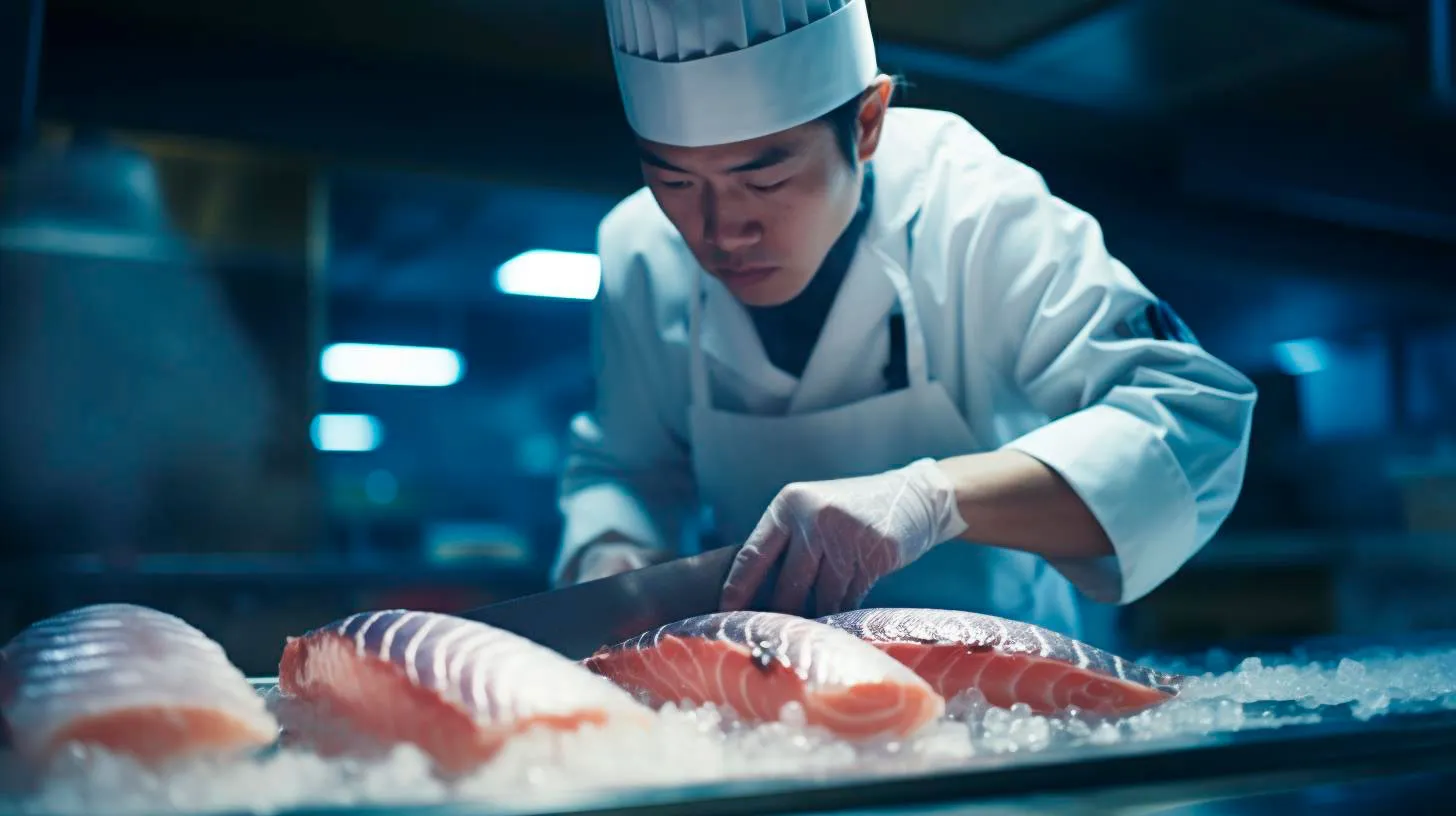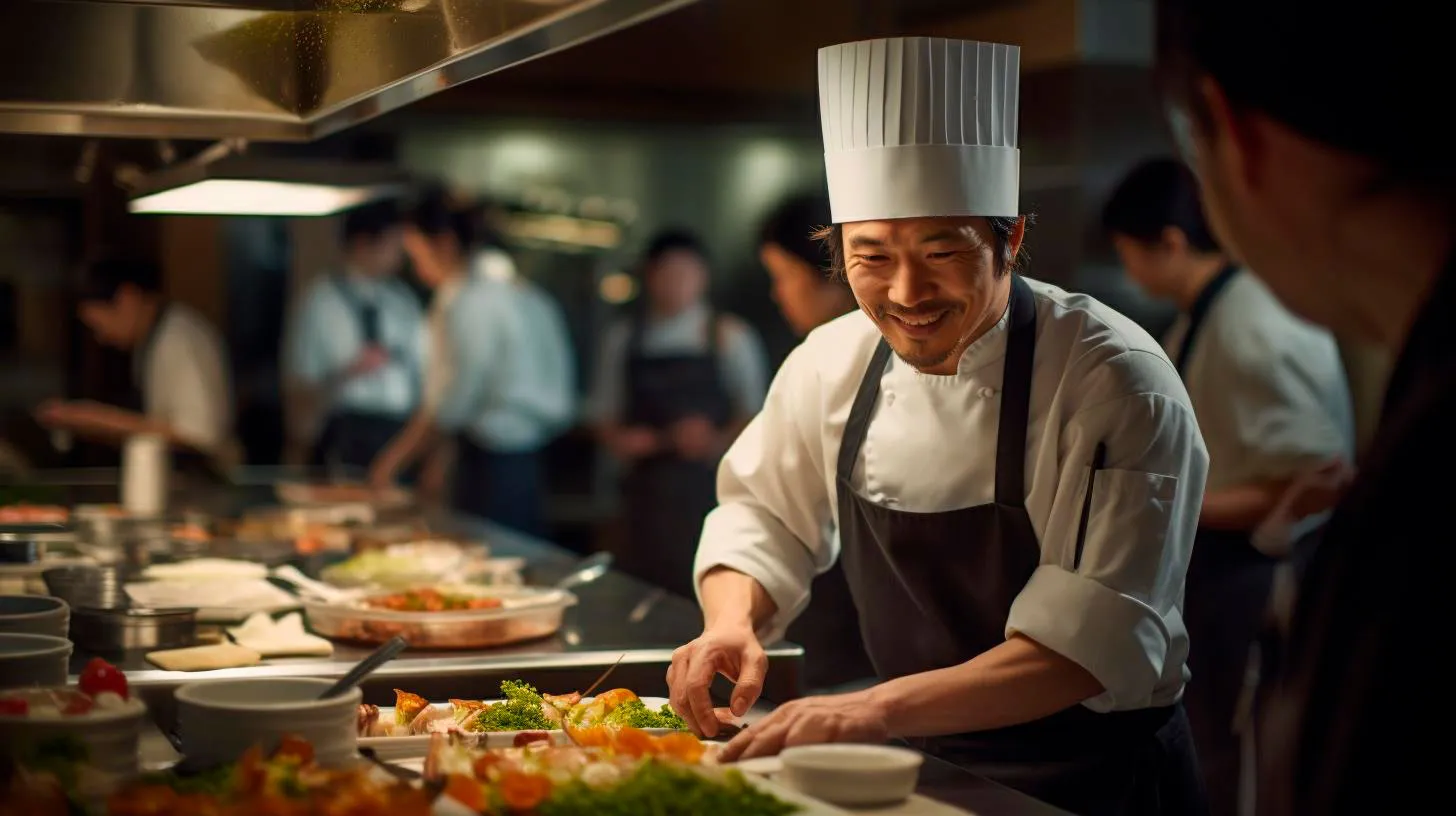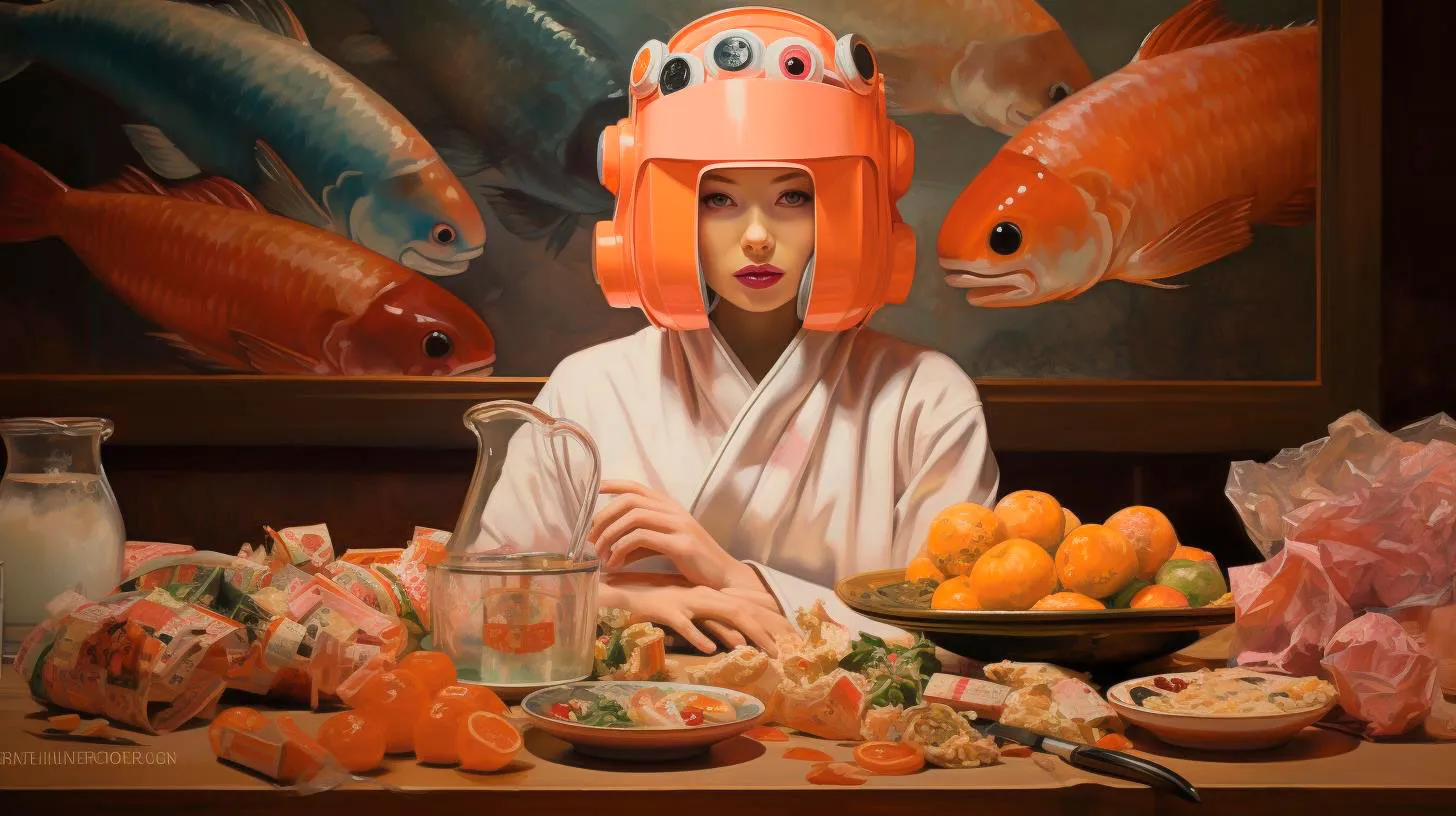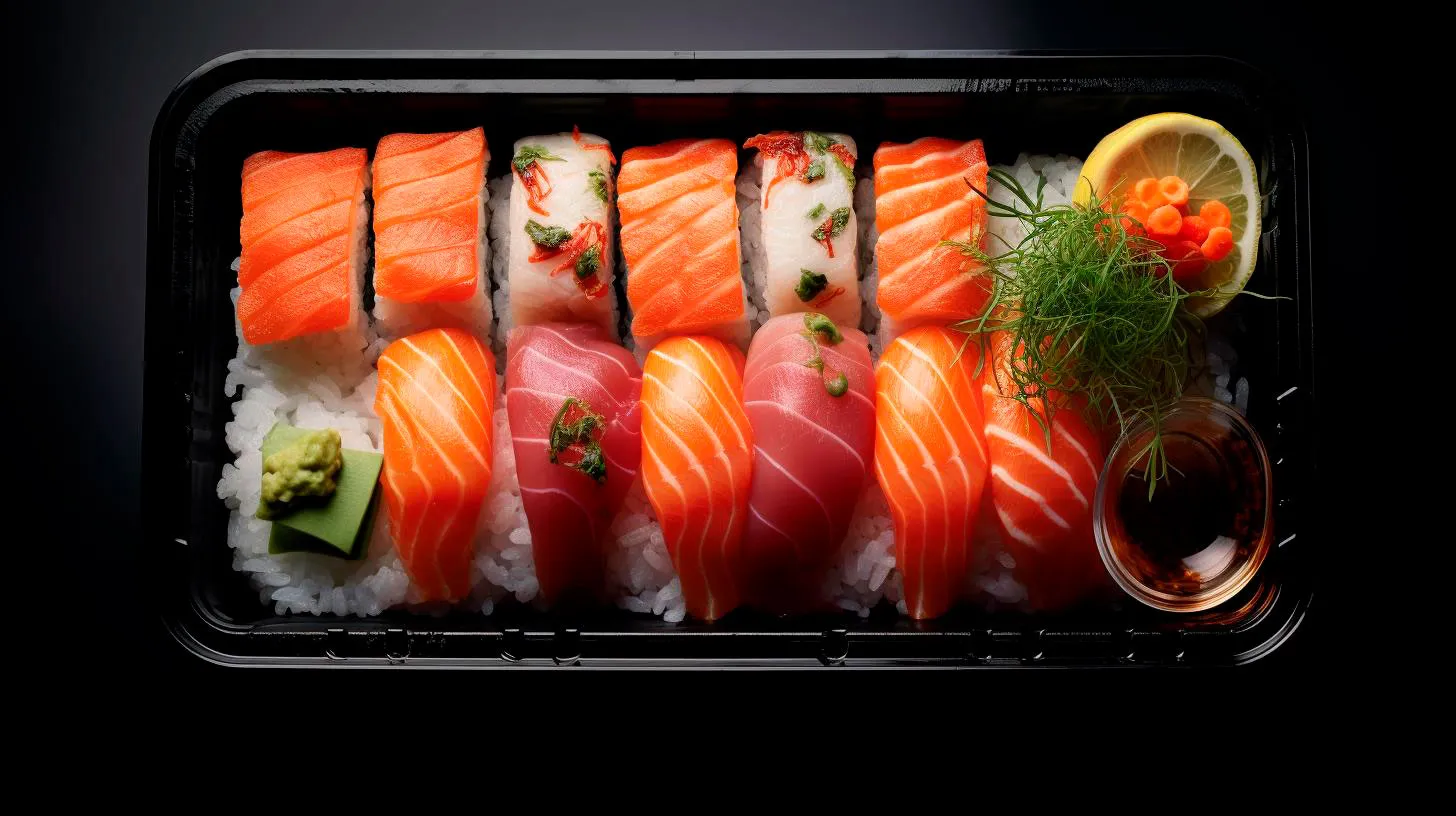Designing Delicacies: Exploring the Aesthetic Influence of Sushi
In this article, we will delve into the aesthetic influence of sushi, exploring how its visual appeal enhances its overall appeal and discussing the key design elements that make sushi a treat for all the senses.
Aesthetics at its Finest: The Beauty of Sushi
No discussion about sushi’s aesthetics can begin without mentioning the vibrant colors that adorn each plate. From the vivid green of the avocado to the deep red of the tuna, sushi is a vivid and colorful display. These colors not only appeal to our visual senses but also provide insights into the ingredients used. The contrast of vibrant fish against white rice creates a stunning composition that captivates the eye. Moreover, the carefully arranged garnishes like delicate daikon radish or vibrant microgreens provide the finishing touches, resulting in a visually dazzling presentation.
- Sushi is a visually striking dish with its vibrant and contrasting colors.
- The arrangement of ingredients and garnishes creates visually appealing compositions.
- Colors and presentation provide insights into the quality and freshness of ingredients.
Aside from color, the textural contrast in sushi is another aspect that adds to its visual appeal. The combination of the soft, tender fish and the firm, sticky rice creates an intriguing textural experience. Sushi chefs are meticulous in crafting nigiri, ensuring that the rice is perfectly formed and tightly wrapped around the fish. The texture of sushi is not only visually appealing but also plays a significant role in the overall sensory experience it offers.
The Art of Sushi Plating
The presentation of sushi is an art form in itself. Each dish is thoughtfully arranged to showcase its ingredients, creating an aesthetically pleasing composition that entices diners. A simple sushi roll, for instance, can be transformed into an eye-catching creation by cutting it into precise, bite-sized pieces and arranging them in an appealing manner. The use of negative space, where the sushi pieces are strategically placed to create balance and harmony, is another technique utilized in sushi plating. This attention to detail elevates the dining experience and brings a sense of refinement to the dish.
- The arrangement of sushi showcases the ingredients and their freshness.
- Sushi plating utilizes negative space and balanced composition for an aesthetically pleasing presentation.
- Precision in cutting and arranging sushi highlights the chef’s skill and attention to detail.
Moreover, sushi’s visual appeal is not limited to the dish itself; it extends to the tableware and serving plates. Traditional Japanese tableware, such as beautifully crafted ceramic dishes and lacquerware, complements the visual aesthetics of sushi, creating a harmonious dining experience. These carefully selected serving vessels enhance the presentation of sushi, elevating it to a form of art that satisfies not only our taste buds but our desire for visual beauty as well.
The Perfect Blend: Fusion of Taste and Design
When considering the aesthetic influence of sushi, it is important to recognize that the visual appeal is not separate from its overall flavor and taste. Sushi’s design elements are not just for show; they enhance the culinary experience as a whole. The balance of flavors, textures, and visual appeal work together harmoniously, providing a multi-sensory experience.
- The visual appeal of sushi enhances the overall culinary experience.
- Design elements of sushi, such as color and texture, complement the flavors.
- Multi-sensory experience of sushi elevates it to a unique culinary delight.
Additionally, the aesthetics of sushi have had a profound influence on various modern culinary trends. From fancy fusion sushi rolls to visually stunning omakase presentations, the influence of sushi’s aesthetics can be seen in contemporary fine dining. Its impact extends beyond Japanese cuisine, inspiring chefs worldwide to incorporate design elements into their dishes and elevate the dining experience for their guests.
Key Takeaways
- Sushi’s vibrant colors and carefully arranged garnishes create visually appealing compositions.
- The textural contrast between fish and rice adds to its visual and sensory appeal.
- Precision in cutting and arranging sushi highlights the chef’s skill and attention to detail.
- Serving vessels and tableware complement the visual aesthetics of sushi, enhancing the dining experience.
- The visual appeal of sushi works harmoniously with its flavors and tastes to provide a multi-sensory experience.
- Sushi’s aesthetics have influenced contemporary culinary trends across the globe.
In conclusion, sushi’s aesthetic influence cannot be underestimated. Its vibrant colors, delicate arrangement, and meticulous presentation create a visual experience that captivates diners. The fusion of taste and design in sushi elevates it to a form of art, satisfying not only our taste buds but also our desire for visual beauty. Dive into the world of sushi, and let your senses be mesmerized by the design intricacies of this culinary delicacy.
The Art of Plating: Transforming Food into Design
In this article, we will explore the concept of plating as a form of design, its impact on the culinary industry, and how it can elevate a dining experience to new heights.
The Importance of Food Presentation
Visual appeal plays a crucial role in our perception of food. Studies have shown that people’s enjoyment of a meal is influenced not only by its taste but also by its presentation. Beautifully plated food stimulates multiple senses, evokes curiosity, and enhances the overall dining experience. The use of design principles in plating introduces a new dimension to how we appreciate and enjoy food.
When food is intentionally plated to create an aesthetic appeal, several benefits emerge:
- Enhanced dining experience: Thoughtfully designed plates can heighten the sensory experience, making each bite more memorable.
- Increased customer satisfaction: Attention to detail in food presentation can leave a lasting impression on diners, resulting in higher satisfaction rates and potential return visits.
- Brand differentiation: For restaurants and chefs, unique and artistic plating styles can set them apart from competitors, leading to increased visibility and recognition in the culinary industry.
The Principles of Plating as Design
Similar to traditional design disciplines, plating follows certain principles that help create visually appealing compositions. Some key principles to keep in mind when approaching food plating are:
Balance:
A well-balanced plate takes into consideration visual weight, color, and texture. The placement of ingredients should create a harmonious composition.
Contrast:
Contrasting elements, such as using vibrant colors against a neutral background or combining crunchy and creamy textures, can make a dish visually striking.
Proportion:
Proper proportion ensures that all components on the plate are adequately portioned and visually cohesive. Plating should consider the size of the plate used and avoid overcrowding or leaving empty spaces.
Focus:
An intentional focus point on the plate draws the eye and creates a strong visual impact. This can be achieved through placing the main ingredient strategically or using a unique plating technique.
Color:
Color is a powerful tool in plating. Combining vibrant colors can evoke certain emotions and create visually captivating plates. Additionally, utilizing natural colors found in fresh ingredients can convey a sense of health and freshness.
The Role of Technology in Plating
Technology has revolutionized the art of plating, providing chefs with tools and techniques to elevate their creations to new heights. Some technological advancements that have influenced the plating process include:
- 3D food printing: Chefs can now utilize 3D food printers to create intricate designs and shapes with various ingredients, adding a touch of innovation to their plating.
- Sous vide cooking: Sous vide cooking allows for precise control over the texture and doneness of ingredients, ensuring consistency in plating and presentation.
- Social media: The rise of social media platforms, such as Instagram, has created a platform for chefs to showcase their visually stunning creations, leading to a greater emphasis on plating aesthetics.
- Plating apps and software: Some chefs rely on specialized software or apps to test and visualize plating ideas, allowing them to experiment and perfect their designs before actual implementation.
The Future of Plating
The art of plating continues to evolve as chefs push boundaries and challenge traditional norms. Looking ahead, several trends and advancements are expected to shape the future of plating:
- Interactive plating: Chefs are experimenting with incorporating interactive elements into their dishes, allowing diners to participate in the plating process, creating a unique and memorable dining experience.
- Sustainable plating: With a growing focus on sustainability, chefs are exploring eco-friendly plating options, such as utilizing biodegradable materials or incorporating locally sourced ingredients.
- Merging culinary cultures: The blending of diverse culinary techniques and ingredients from different cultures leads to innovative plating styles that offer a fusion of flavors and aesthetics.
The art of plating goes beyond just serving food; it is a means of self-expression, creativity, and pushing the boundaries of culinary experiences. By embracing design principles, utilizing technology, and constantly innovating, chefs can transform ordinary dishes into extraordinary works of art that tantalize both the eyes and the taste buds.
Sushi as a Canvas: The Visual Appeal in Food Competitions
Food competitions have long been popular, with chefs battling it out to create the most delicious and visually stunning dishes. However, sushi has managed to stand out in these competitions, thanks to its intricate and visually striking presentation. Let’s explore the role of visual appeal in food competitions and how sushi has become a favored medium for culinary artists.
The Power of Visual Appeal
In food competitions, visual appeal plays a crucial role in captivating the judges and enticing the audience. It is said that we eat with our eyes first, and chefs understand the importance of creating visually stunning dishes that excite the senses.
Here are some key reasons why visual appeal is important in food competitions:
- First impressions: Participants need to make a lasting impression on the judges, and visual appeal is their first chance to do so.
- Enhanced taste perception: When a dish looks beautiful, it subconsciously tricks our brain into perceiving it as more flavorful and enjoyable.
- Captivating the audience: In food competitions, the audience’s engagement is just as crucial as the judges’ decisions. Dazzling visuals leave a lasting impact on viewers.
- Instagram-worthy dishes: In the era of social media, visually appealing dishes have the potential to go viral, attracting even more attention and recognition.
Sushi: A Canvas for Culinary Art
Among the various dishes presented at food competitions, sushi has emerged as a popular choice for both contestants and judges. Its combination of flavors and textures, along with the potential for artistic presentation, makes it an ideal canvas for culinary artists.
Here’s why sushi stands out as a creative medium in food competitions:
- Versatility: Sushi offers endless opportunities for chefs to experiment with ingredients, shapes, and colors.
- Artistic presentation: From intricate garnishes to vibrant sauces, sushi allows chefs to showcase their creativity through visually appealing designs.
- Precision and attention to detail: The art of sushi-making requires impeccable precision and attention to detail, which adds to its overall aesthetic appeal.
- Uniqueness: Sushi stands apart from other dishes due to its artistic presentation, making it a memorable choice for judges and audiences alike.
The Impact of Sushi’s Visual Appeal
The visual appeal of sushi has had a significant impact on food competitions, both in terms of recognition and social media. It has become a powerful tool for chefs to showcase their skills and gain recognition for their artistic creations.
Key takeaways from the impact of sushi’s visual appeal:
- Judging criteria: In many food competitions, visual appeal has been incorporated into the judging criteria, emphasizing the importance of the dish’s aesthetic value.
- Celebrity chefs: Through food competitions, many sushi chefs have garnered fame, becoming celebrities in their own right.
- Social media exposure: Pictures and videos of visually appealing sushi dishes have trended on platforms like Instagram and TikTok, attracting a wider audience.
- Inspiring innovation: The visual appeal of sushi has inspired other culinary artists to push boundaries and explore new techniques in their own dishes.
Conclusion
Sushi’s evolution from a traditional dish to a work of art demonstrates the growing importance of visual appeal in food competitions. Chefs understand that a visually stunning dish can have a significant impact on judges, audiences, and even online engagement. Sushi’s versatility, combined with the precision and attention to detail it requires, makes it an ideal medium for culinary artists to showcase their creativity. As food competitions continue to grow in popularity, we can expect sushi to remain at the forefront as a captivating and Instagram-worthy dish that delights both the eyes and the taste buds.
Culinary Masterpieces: How Sushi Elevates Food Competitions
Whether it’s a local culinary showdown or a prestigious international event, sushi has proven to be a formidable contender that elevates these competitions to a whole new level.
The Craftsmanship Behind Sushi
Before we dive into the exhilarating world of sushi in food competitions, let’s take a moment to appreciate the craftsmanship behind this extraordinary culinary masterpiece. Sushi chefs, also known as Itamae, dedicate years perfecting their skills to create sushi that not only excites the taste buds but also pleases the eyes.
- Every slice of sashimi is meticulously cut with precision, ensuring a harmonious balance of flavors and textures.
- The art of sushi making involves a meticulous process that requires passion, patience, and an impeccable eye for detail.
- The presentation of sushi is equally important, with chefs often showcasing their creativity through intricate arrangements and eye-catching plating techniques.
The Rise of Sushi in Food Competitions
The popularity of sushi in food competitions can be attributed to its unique appeal and the artistry involved in its creation. Here are some reasons why sushi is taking these competitions by storm:
- Exquisite Flavors: Sushi offers an explosion of flavors derived from the freshest ingredients, including succulent fish, flavorful seaweed, and delicate rice. Judges and spectators are captivated by the complex taste profiles that sushi showcases.
- Visual Spectacle: In food competitions, presentation plays a vital role in the overall judging process. Sushi’s vibrant colors, meticulous cuts, and beautifully arranged pieces make it a visually stunning dish that mesmerizes both the eyes and the palate.
- Challenging Technique: Sushi making requires technical expertise and precision. From perfecting the rice texture to creating flawlessly rolled maki, contestants must demonstrate a high level of skill and mastery to impress the judges.
Key Takeaways from Sushi in Food Competitions
As food competitions continue to gain popularity, sushi enthusiasts can draw inspiration and key takeaways from this culinary art form:
Showcase Creativity:
Sushi provides a platform for chefs to unleash their creativity. By experimenting with unique ingredient combinations and innovative presentation techniques, aspiring chefs can push the boundaries of traditional sushi and create their own masterpieces.
Focus on Quality:
In sushi competitions, quality is paramount. Using the freshest and highest quality ingredients ensures that each bite delivers an exceptional dining experience. The commitment to sourcing top-notch ingredients can be applied to all culinary endeavors, elevating the overall quality of the dishes.
Precision and Attention to Detail:
With sushi, every detail matters. From the precise knife cuts to the meticulous placement of ingredients, attention to detail is what sets a winning dish apart. By incorporating this level of precision and attention to detail, chefs can elevate their culinary creations in other aspects of cooking.
When it comes to sushi in food competitions, the combination of flavors, visuals, and craftsmanship creates an exciting atmosphere that captivates both competitors and spectators. With its growing popularity, we can expect to see even more innovation and artistry in the world of sushi competitions. So, let your taste buds embark on a culinary journey and immerse yourself in the awe-inspiring world of sushi!



